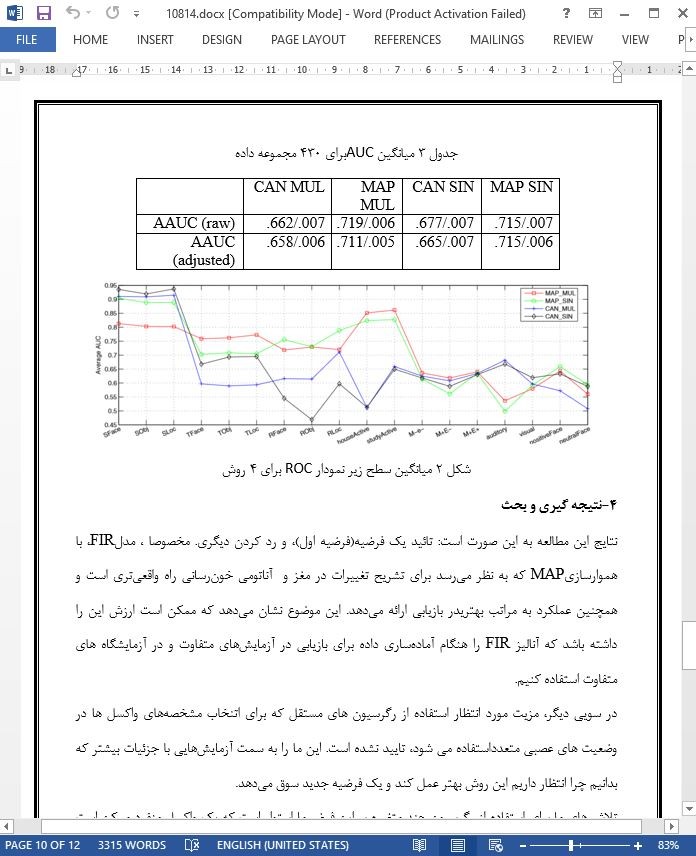
تاثیر مدل پاسخ ضربه محدود در بازیابی تصویر FMRI براساس محتوا
چکیده
نقشه تی آستانهای تولیدشده توسط مدل خطی عمومی (GLM) خلاصهای موثر از الگوهای فعالساز در تصاویر مغزی کاربردی را ارئه میدهد و به طور گسترده برای انتخابهای آینده در FMRI مربوط به امور طبقه بندی استفاده میشود. به عنوان قسمتی از پروژه ساخت سیستمهای بازیابیمحتوایی برای تصاویر FMRI، روش هایی را بررسی کردهایم که بتوانند GLM را سازگارتر و قویتر در مواجه با دادههای FMRI به دست آمده از آزمایشهای مختلف بکند. در این مقاله ما گزارشی از شناسایی مدل پاسخ ضربه محدود، که با رگرسیون خطی چندگانه ترکیب شده است، را برای شناسایی بهترین تابع پاسخ همودینامیک از نظر محل قرار گیری برای هر واکسل (HRF)، و تخمین همزمان سطوح فعالسازی متناظر با حالتهای محرک متفاوت، ارائه میدهیم. هدف توسعه روشی برای پردازش دادههایی با ماهیتهای متفاوت است. آزمایشهای ما نشان میدهد که مدلهای پاسخ ضربه محدود (FIR) با ضرایب صاف شده عملکرد بازیابی بهتری را نسبت به روش گاما دوگانه استاندارد از نظر درستی بازیابی تولید می کند.
1 معرفی
به عنوان روشی برای پاسخ به این پرسش که "مغز چگونه کار میکند" ، FMRI تبدیل به ابزار تحقیق قدرتمندی در بسیاری از زمینههای مطالعات علوم اعصاب در دهه های گذشته شده است [1]. اخیرا، طبقهبندی تصاویر FMRI، براساس تشابه بین الگوهای فعالسازی، تحول امیدوارکنندهای برای تشخیص بالینی را نشان میدهد[2,3,4]. این روشها معمولا ویژگیهایی (که باید گفت، واکسلها یا محلهایی در مغز و سطوح فعالسازی آنها) و سلسلهمدلهایی را برای تمیز دادن موارد غیر معمول از موارد اصطلاحا معمول انتخاب میکند.
4-نتیجه گیری و بحث
نتایج این مطالعه به این صورت است: تائید یک فرضیه(فرضیه اول)، و رد کردن دیگری. مخصوصا ، مدلFIR، با هموارسازیMAP که به نظر میرسد برای تشریح تغییرات در مغز و آناتومی خونرسانی راه واقعیتری است و همچنین عملکرد به مراتب بهتریدر بازیابی ارائه میدهد. این موضوع نشان میدهد که ممکن است ارزش این را داشته باشد که آنالیز FIR را هنگام آمادهساری داده برای بازیابی در آزمایشهای متفاوت و در آزمایشگاه های متفاوت استفاده کنیم.
Abstract
The thresholded t-map produced by the General Linear Model (GLM) gives an effective summary of activation patterns in functional brain images and is widely used for feature selection in fMRI related classification tasks. As part of a project to build content-based retrieval systems for fMRI images, we have investigated ways to make GLM more adaptive and more robust in dealing with fMRI data from widely differing experiments. In this paper we report on exploration of the Finite Impulse Response model, combined with multiple linear regression, to identify the “locally best Hemodynamic Response Function (HRF) for each voxel” and to simultaneously estimate activation levels corresponding to several stimulus conditions. The goal is to develop a procedure for processing datasets of varying natures. Our experiments show that Finite Impulse Response (FIR) models with a smoothing factor produce better retrieval performance than does the canonical double gamma HRF in terms of retrieval accuracy.
1 Introduction
As a method for watching “how the brain works”, fMRI has become a powerful research tool in many aspects of neuroscience studies in the past decade [1]. More recently, classification of fMRI images, based on similarity between activation patterns, shows promising transition to clinical diagnosis [2,3,4]. These methods usually select features (that is to say, voxels or areas in the brain and their activation levels) and train models to best distinguish uncommon cases from so-called “typical” ones.
4 Conclusions and Discussions
The results of this study are: confirmation of one hypothesis (H1) , and some tantalizing clues regarding the other. Specifically, the FIR model, with MAP smoothing, which seems to be a more realistic way to describe the variations, across the brain, in the anatomy supplying blood, does also yield significantly better performance in the retrieval setting. This suggest that it may be worth the added effort to use smoothed FIR analysis when preparing data for retrieval across different experiments, and different laboratories.

چکیده
1 معرفی
2 روش
1.2 طرح های انتخاب ویژگی بر اساس GLM
2.2 مدل پاسخ ضربه محدود(FIR)
3.2 مدل FIR برای وضعیتهای چندگانه همزمان
3 نتایج
4-نتیجه گیری و بحث
Abstract
1 Introduction
2 Method
2.1 GLM Based Feature Selection Schemes
2.2 Finite Impulse Response (FIR) Model
2.3 FIR Model for Multiple Conditions at the Same Time
3 Results
4 Conclusions and Discussions
- ترجمه فارسی مقاله با فرمت ورد (word) با قابلیت ویرایش، بدون آرم سایت ای ترجمه
- ترجمه فارسی مقاله با فرمت pdf، بدون آرم سایت ای ترجمه
